Lendi Bagh is situated on the North East Corner in Shirdi. It is Vaikuntha (Heaven) on earth. During the early days of his sojourn in Shirdi, Saibaba used to go early in the morning to Lendi Bagh.
Lendi was the name of a little stream on the outskirts of the village. Hence the land nearby was called 'Lendi Bagh' by Baba. Baba was rather rigid in this routine, and everyday He made His rounds in the morning and afternoon to Lendi Bagh, often accompanied by His Bhaktas, Butti, Bhagoji and Nimonkar but He entered the garden alone and spent sometime. This Lendi garden was purchased by Moreshwar Pradhan. A few years before the land was purchased, Baba took Pradhan and the two sons of Chandorkar to Lendi Bagh. There Baba dug small holes in the earth and gave some corn to Pradhan to put in the holes which He covered with earth and asked Pradhan to water them. Pradhan gave wonderful relevance to this incident as being the first seeds of thought in his mind to buy this land for Baba's use. This event of sowing of seeds in Lendi Bagh by Pradhan happened in May 1918 (ref: Shirdi Gazetteer). Accordingly, Pradhan bought this Bagh and presented it to Baba. From then onwards devotees started taking Baba in procession to and from Lendi Bagh. The devotee who visit Shirdi can see the board above the gate that reads “Moreshwar Pradhan Che Lendi Bagh”
Lendi Bagh is a treasure trove, sanctified by the dust of Baba’s feet, and the solitary time he spent there each and every day. This garden was full of trees, and flowering plants like Parijata, Champa, Chameli, Jui and Jai. Upto 1980’s this garden had a beautiful entrance which was a canopy of flowering bougainvillea. On the left side entrance of Lendi Bagh, there was another rose garden where deer and rabbits roamed about.
The trees like Aamra (Mango), Ambore (Tarvad, an indigenous tree), Arista (Neem), Ashwatha (Peepul) and Audumbar (Umbar) were planted and nurtured by Baba Himself. According to Hindu mythology these trees are considered holy, as a deity resides in many of these trees.
The specialty of Tarvad Plant is that it is an all season plant which can grow in any condition or irrespective of season and climatic condition). The flower of this plant is very good for health as it is believed to enhance the immunity system and also very effective in the control of Diabetes.
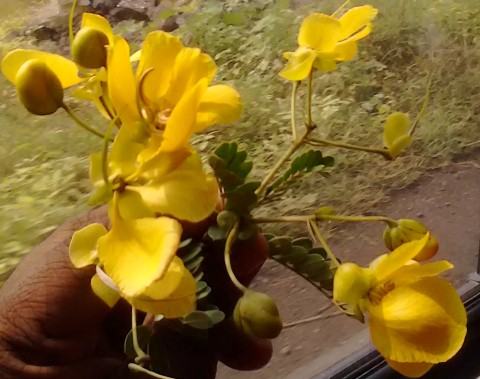
Ambore or Tarvad flower
Lendi Bagh was about an acre in length and breadth. The Lendi was a small, very old and famous river. It flowed underground and then emerged in Lendi Bagh. There it divided the garden into two parts. In Lendi Bagh it flowed slowly and more like a stream. The water was scanty for most part of the year. Baba went to Lendi Bagh daily and every day he threw some silver coins in the Lendi.
Baba used to test his devotees to see if they hankered after money and gold. Once he asked Purandare to accompany him to Lendi Bagh. Together they went to the Lendi stream and stood near the bank. Then Baba showed him three dazzling plates of gold. The plates were in the stream and Baba pointed to them. Purandare was not in the least tempted and did not even bother to glance at them.
On another occasion, Baba took another devotee Jyotindra to the Lendi stream. He showed him lumps of gold, and asked him to take as much as he wanted. But, Jyotindra was not at all concerned. His only intention was to be with Baba and develop spirituality.
Although Baba was surrounded by devotees all the time, he kept rather a strict schedule. He went to Lendi Bagh daily at about 8 a.m. in the morning and again at about 3 p.m. in the afternoon.
The musical band would be ready and waiting for him every day. He always entered Lendi Bagh alone, while the band and the devotees would return. Baba used to enter Lendi Bagh through the west. He also sat facing the west with his back to the Nanda Deep.
Abdul Baba brought pitchers of water for him which he threw in all directions along with incantations and chants. He used to utter something during that time.
Saibaba like a gardener went to the Lendi Bagh to nurture the plants. The plants are his devotees, and he pulled out the weeds. The weeds are symbolic of the evil tendencies that pull us in different directions.
There were many fragrant flowering plants in the 1920s. There were many peacocks, deer, rabbits, mongoose and birds. The Lendi Bagh was like this up to the 1980s.
But, now with the Shirdi Saibaba Sansthan’s beautification plan, the Lendi Garden has gone through many changes. Now the devotee can see a portion of the Lendi Garden landscaped and a waterfall being present in the entrance of the Lendi Garden
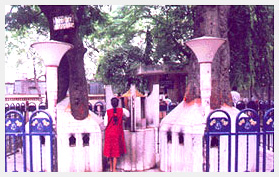
Ganesh and Shivaling below Peepal and Neem Tree
As the devotee enter Lendi Baugh they will see a very old and small shrine dedicated to Ganesh and Shivaling
below the Peepal and Neem Tree.
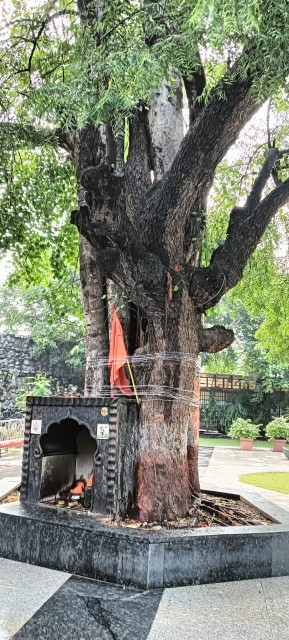
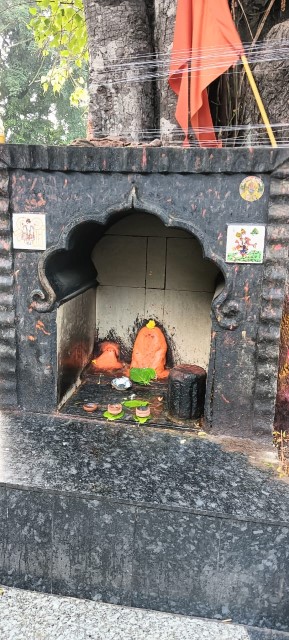
Neem Tree
To the left of the Nanda Deep there were two Neem trees. These trees were planted by Baba. Unfortunately, both these trees died and hence one of them was cut from the base. The other neem tree was cut and over the stump a creeper is being grown.
The botanical name of Neem is Azadi Rachita Indica. In Sanskrit it is known as Nimba which means bestower of health. The Hindu mythology says that Amrit (Ambrosia) fell on the neem tree. Another myth is that the sun took refuge in it to escape the demons.
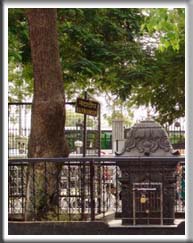
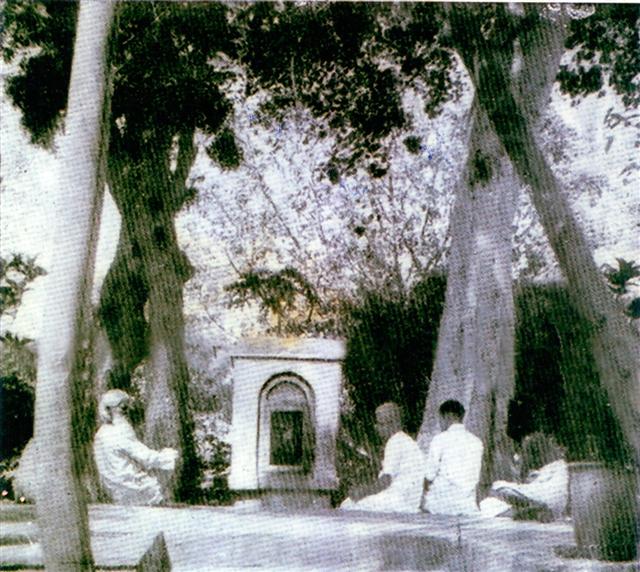
Narasimha Swamiji sitting along with devotees in front of Nanda Deep
The neem tree symbolizes Devi Roopam (Goddess). Purusha and Prakriti are inseparable. In the case of all Gods (Saguna Roopa was given by us). This being represented by male and female roopa. Whereas Saibaba is Paripoorna Parabrahma, so there is no separate roopa of Prakriti. Thus unlike other Gods, he does not have a female counterpart.
By sitting under the neem tree he is conveying to us that “Maya which is his own creation; is totally under his control and he conditions it”. This Maya cannot act upon him as it would act on us. But having taken a human form to be in this universe, he too needs Maya. The whole of the universe, the cosmos, and Maya was created by him. The only difference is that Maya is under his control unlike us who are under the control of Maya.
It is believed that worshipping the Neem tree bestows Ayu (longevity), Shri (prosperity), Yasha (fame), and Viaya (victory).
Nanda Deep
Baba lit this Akhand Nanda Deep. When exactly it was lit is not known. In those days it was placed in a pit and Abdul Baba looked after it. Abdul Baba states that Baba sat with His back to the 'Jyoth’ and from there the lamp was not visible to Baba. Daily Abdul brought pots to water and placed them near the Nanda Deep and Baba poured water in various directions.
In 1942, Galvankar built a platform over which the Nanda Deep was mounted. Later it was placed over a marble pillar and shielded with glass case and protected from the elements. During the beautification plan of Shirdi Saibaba Sansthan in the year 1998, it was placed in the present container.
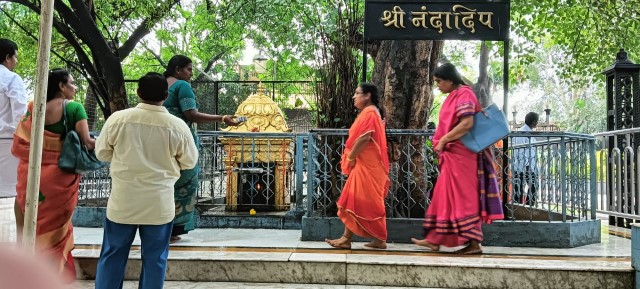
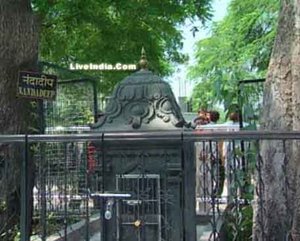
A few years ago the Pujari of the Gurusthan used to attend to it, to keep it perpetually burning as Baba did. Later on, Parayan Kaksh was moved to the hall adjacent to the Kapad Koti. Hence, the Poojari of the Parayan Kaksh looks after it now. He also looks after the Dattatreya Mandir.
In Mahanarayanopanishad it is explained that Fire is the life force of all living beings. The Light eradicates and wards off all obstacles in our Sadhana Margaand protects everyone under its care.
Hence, it is a practice followed by many Sai Devotees to do 108 Pradakshina of Nanda Deep.
The Ashwatha or Peepal Tree
This aged Peepal tree was already there when Baba came to Shirdi. This holy tree is present to the right of the Nanda Deep. Baba went daily to Lendi Bagh and spent two to three hours below these trees (Neem and Peepal). This Peepal tree began to dry up and Baba gave life to it and made Navgraha installation in this tree, as a mark of which the stem of this tree has nine large branches and nine roots. Baba watered this tree daily and looked after it. There is also a Ganesha formation on this tree.
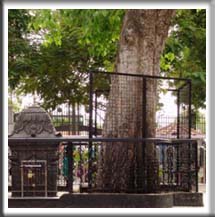
Devotees do Pradakshina starting from the Nanda Deep around the Neem trees, then the Peepal tree and back to Nanda Deep. This will complete one Pradakshina. Having done so they bow to Nanda Deep which is the giver of 'light of knowledge',the Neem tree is symbolic of Lakshmi and the Peepal is Ashwatha representing Lord Shri Krishna, because Lord Krishna chose the Peepal tree to depart from this earth. This particular Peepal tree having the Navgraha and Ganesh on it is considered very sacred. The Brahma and Padma Puranas state, “Once there was a fierce battle between the Gods and the demons; Lord Vishnu sought refuge by hiding in the Ashwatha tree”. This tree also represents the Trimurti. In its roots resides Brahma, in the trunk resides Vishnu and in the leaves resides Shiva.
The Ashwatha tree is sacred for the Buddhists as Buddha received Nirvana under this tree. This tree is also called as the Bodhi Tree. It is believed that Goddess Lakshmi sits on it on Saturdays.
In the Jnaneshwari, Chapter 15, Ovi 1-3, Lord Krishna explains the meaning of this tree beautifully. The Lord said:
Ovi 1, “The tree has roots on the top, and branches downwards. The tree is endless and is called Ashwatha. The Vedas are its leaves and one who knows this tree is the knower of the Vedas”.
Ovi 2, “Fed by the three Gunas, it has sense objects as tender leaves. The branches in the shape of different orders of creation spread above and below. Its roots bind the soul according to the actions of the human beings, spread themselves in all regions above and below”.
Ovi 3, “On careful observation this tree of worldly life does not prove to be of that nature as it seems apparently to be, because it has no beginning, no end nor even stability. Fell this Ashwatha tree with a formidable axe of detachment”.
The women after prayer ceremoniously tie a string round the peepal tree for the longevity of their husbands.
Baba's Well
This well is in the middle portion of the Lendi Bagh. It is situated straight ahead of the floral canopied entrance, by the side of the western compound wall. Baba Himself with the manual help of His devotees both rich and poor dug and built this well. Baba used to drink water from this well, and he called it Budki. The water of this well became famous in the vicinity, for driving away fevers and other ailments. Previously devotees used to take water from this well, and then it gradually dried up. In 1983 A.R. Shinde deepened this well and water was found in abundance. There were two wells in Shirdi in those days, one in Lendi Bagh and the other was on the left side of the exiting stairs of the Samadhi Mandir.The well that was present near Samadhi Mandir exit stairs does not exist anymore.
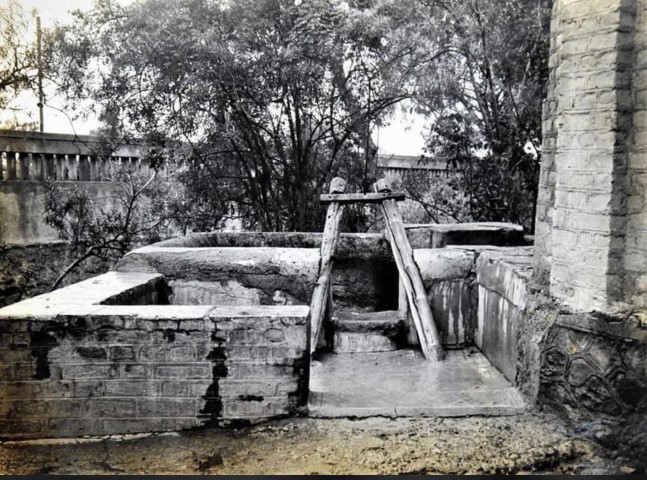
Photo Courtesy: Shri.Vinesh, Bangalore

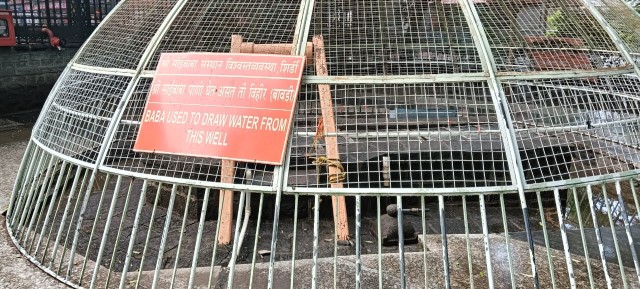
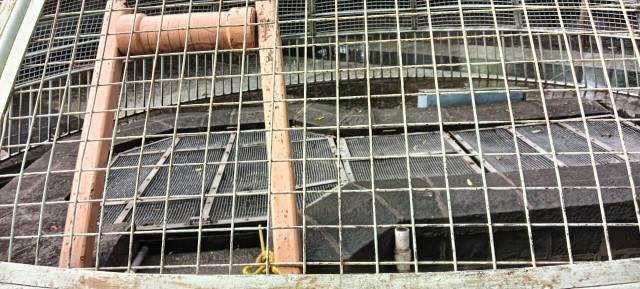
Suspending the disciple in the inverted position in the well is a traditional Sufi Technique which would result in the transformation of the disciple; this is known as Tawahat. Here the well symbolizes a place containing the cool waters of peace, where turning the student in an inverted position (head downwards) over a well means turning down or overturning ego. By overturning ego, one could reach cool waters of peace. This whole process is conducted by the Guru.
In Chapter 32 of Shri Sai Satcharitra under the title “Greatness of the Guru” the Leela of Baba being suspended in the well is given.
The other possible meaning could be that ‘we’ are deep in the well of materialistic world. But when the Sadguru comes to us, he being merciful will tie our hands and legs (the organs of movement). Then he will ties us in the inverted position with the head downwards, thus making the body vomit out the false ‘I’ Thus we become detached from the worldly pleasures, and their consequential results, although we live surrounded by them. In simpler terms He teaches us to be in this transient world and exist in the most detached way.
Devotees visiting Shirdi do not forget to throng to this well and take Darshan of it as it was dug by Baba Himself.
The Datatreya Mandir
In front of Muktaram’s Samadhi and to the left and a little distance away from Nanda Deep is the Dattatreya Mandir. This temple was built by two local devotees of Baba who would like to remain anonymous. The Prana Pratishta of the Idol of Lord Dattatreya and Marble Padukas was performed by Shirdi Saibaba Sansthan with due formalities on 6th December 1976 (ref: Shirdi Gazetteer). The religious rites and rituals were conducted by Shri.Vasant Shastri Deshmukh of Kanyakumari Upasani Ashram, Sakori. There is a small Audumbar tree behind this temple. The Pujari from the Gurusthan looks after this temple. In the morning, there is Mangal Snan, Alankar, and the clothes are changed. Bhog is offered three times a day.
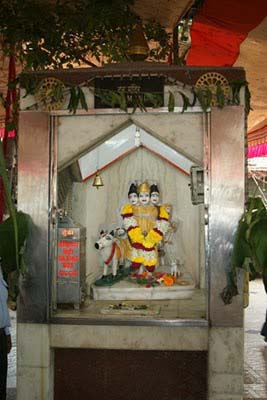
Silver Padukas were installed here on Datta Jayanthi on the 12th December 2008.
On Datta Jayanthi Day, the Pujaris from the Samadhi Mandir do Arati to Lord Datta. The devotees make Pradakshina of this temple and get their wishes fulfilled.
During Baba’s sojourn in Shirdi there was a small Datta Mandir behind this Datta Mandir. Baba would often go and stand before it. When the beautification of Lendi Bagh was done by Shirdi Saibaba Sansthan, this temple was removed.
The Samadhi of Shyam Karan
A horse merchant, Kasam, had a mare that was issueless for a long time. He made a vow to Baba that if his mare had issues he would give the first issue to Baba. By the grace of Baba she did have the issues and he gratefully brought the first issue and presented it to Baba. Baba named it 'Shyam Karan'.
The word Shyam literally means black. A flawless black that is pleasing to the eye. But the word in Hindu mythology could mean pure and holy. It has been prefixed to other words to covey different meanings. For example, Shyam Karan is used to refer to Shri Krishna; Shyam Kant to Shri Shankar.
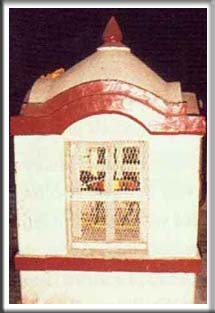
Shyam Karan was the name of the horse or Ashwa of the Ashwamedha. The rinanubandh between Shyam Karan and Baba were deep. At every arati he danced with joy, and after the arati was the first to bow to Baba. This horse loved Baba and would daily lovingly take darshan of Baba. At about one o’clock, the noon arati was performed with grandeur. At that time Shyam Karan was bedecked with a mala (necklace), anklets and tiny bells and looked quite regal, and royal. He stood in the centre of the Sabhamandap (where the marble tortoise is present now in dwaraka mai) and waited patiently for the arati to start. The devotees stood on either side of him. When the arati started he danced merrily keeping beat with the tiny bells tied to his feet. After Baba’s lalkari he climbed the central steps of the Dwaraka Mai and bowed to Baba. Baba reciprocated this love by applying Udi on his forehead and blessed him . Only later, Baba used to give Udi and Prasad to other Bhaktas. The horse symbolizes the whole cosmos bowed before Baba, and danced with joy when Baba was worshipped.
This horse was housed in the room situated on the eastern side of Dwaraka Mai, now called Shyam Sunder Hall. The trainer of this horse, Khajgiwale, saw that the horse was well looked after and decked with all the trappings that are now exhibited in the Museum. Shyam Karan was taught to stand in front of Baba, climb the steps of the Dwaraka Mai and do Namaskar to Baba, and later to Baba’s Samadhi.
After Baba’s Mahasamadhi, he attended the aratis in the Samadhi Mandir and bowed to Baba’s Samadhi. On every Vijaya Dashmi Day, he was decked with all his trappings and was taken out in procession. Before the procession, the devotees would take a one rupee coin and wave it around his head. This is done to dispel the effects of the evil eye.
On Chavadi procession days would be dressed royally and dance all the way to the Chavadi. After Baba entered the Chavadi he stood facing Baba.
Shyam Karan died in 1945, and Shirdi Saibaba Sansthan has honoured this beloved horse of Baba with his Samadhi in Lendi Bagh. In the 1950’s there was a board next to his Samadhi which read “Krishnaji (alias Nana) Khajgiwala was the trainer of Shyam Karan, Baba’s beloved horse, whose Samadhi is here”. But the devotees who visit Shirdi now cannot see any such board.
The Samadhi of Amidas Bhavani Mehta
His Samadhi is in the central part of the Lendi Bagh. Amrutal was his real name. He was a resident of Bhavnagar (Kathewad, Saurashtra). Amidas was from the community of Narsinh Mehta. He was an intellectual poet and a devotee of Lord Krishna. Every time he worshipped Lord Krishna, and looked at the Lord’s photograph, he saw a fakir in the glass. He was perplexed to see a Muslim fakir superimposing Lord Krishna and his curiosity was aroused. So, he set out to find this fakir who was none other than Sai Baba of Shirdi.
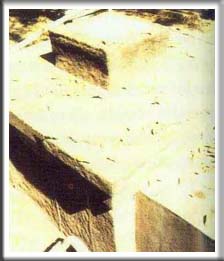
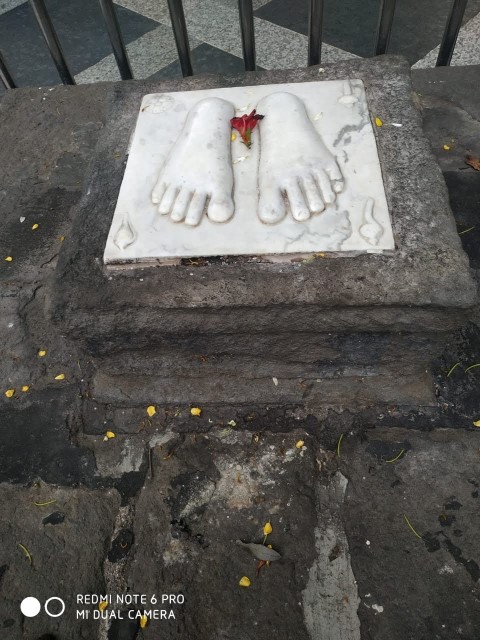
Amidas Bhavani Mehta Samadhi
Amidas was a very learned man, and trained in Indian Classical instrumental and vocal music. He was affluent and attached to a small king named Dayashankar Revashankar Pandya. In those days, Kathewad was divided into small kingdoms, which were ruled by Nawabs.
Being well off he visited Shirdi frequently. He took a room for rent and stayed with Baba for long periods of time. He started writing about Baba in Gujarati, thus spreading the glory of Baba amongst the Gujarati speaking population (Ref.Sai Satcharitha, Chapter II).
Baba loved Amidas for his kind and gentle nature. When somebody was sick in Shirdi, Baba sent him to Amidas to be taken care of. Amidas gladly tended to the patient with tender loving care and nursed him back to health. His only wish was to die in Shirdi in the vicinity of his Guru.
Baba on hearing his wish replied “You may die anywhere, but you will always be with me”. He breathed his last in Shirdi, and his Samadhi is in Lendi Bagh. It is adjacent to the Samadhi of Muktaram. There is a plaque on his Samadhi which reads, “Shri Satchidanand Sadguru Baba Anand Maharaj urf (alias) Amidas Bhavani Mehta budhwar (Wednesday) mithi (Roughly translated it’s the date or tithi) Magh (February-March) Shudh 14 Shake. 2844 (i.e., 31st January 1923).
The Samadhi of Muktharam
Muktaram was a resident of Raverkheda where he lived with his wife, mother, and extended family. Muktaram first visited Shirdi in 1911 when he came with a group of pilgrims. Baba’s divinity had an overwhelming effect on him. He made several visits thereafter and finally made Shirdi his home. He hailed from Ravierked, where he lived with his wife, mother and extended family. Unfortunately his real name is not known. It was Baba who called him Muktaram, so the villagers and other devotees also called him by that name.
He was very affluent. He owned a wada and had vast acres of farm lands. Soon he lost interest in the crops, the farms and his family. The whole day he did Baba’s Naam jap. His only thought was when he could be close to his Sadguru. Finally, he left his family and came to Shirdi.
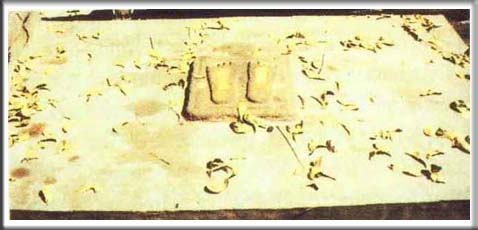
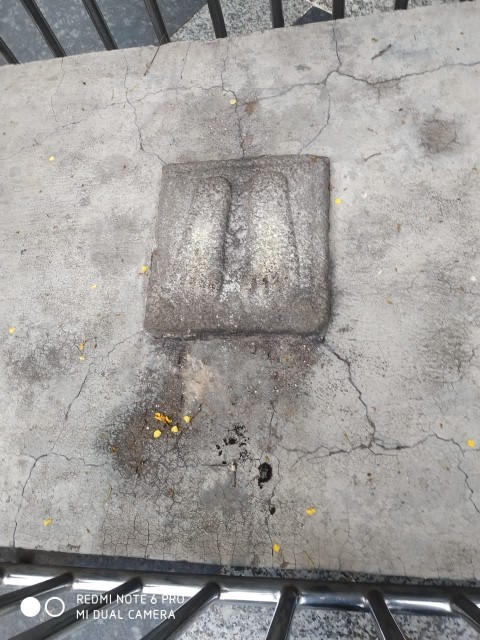
Muktaram's Samadhi
Muktaram was an ascetic by nature, and was willing to do severe penance to gain the grace of his Sadguru. He was very disciplined and would be with Baba from early morning till noon. He sat in front of Baba next to the Dhuni Maa. Whether it was scorching hot or cold, he sat next to the blazing Dhuni Maa. Just as Hanuman sat in front of Shri Rama, or Garuda sat in front of Shri Vishnu, one could see Muktaram sitting in front of Baba. Muktaram’s devotion towards Baba was no less than that of Maruti towards Rama.
He survived on whatever Baba gave him from his Bhiksha. After the noon Arati, Baba had his lunch, then rested a while. Muktaram would go to his room, which was a cramped tin shed adjacent to Dixit’s Wada. There he sat and meditated in front of the Dhuni. Upon Baba’s instruction he had an ever burning Dhuni Maa in his room, and there he sat till it was time for him to go again to the Dwaraka Mai. This penance he did gladly although the room was hot as a furnace.
Muktaram dressed exactly like Baba. He wore a white Kafni, tied a white cloth around his head, and had langoti around his loin. It was Baba who gave him the Kafni , and the white cloth to tie on his head. Muktaram’s intense love, devotion, and concentration on his Guru, soon bore fruit. After some time his way of living became the mirror image of Baba’s lifestyle.
About three months before Baba’s Mahasamadhi, Muktaram was sick with fever and a persistent cough. He spent most of his time in his room. At the time of Baba’s Mahasamadhi his condition was rather serious. Eight days after Baba’s Mahasamadhi, he went to the Dwaraka Mai and returned to his room very quickly. When he was in the Dwaraka Mai he sat on his sack and leaned against the central pillar. After returning from Dwaraka Mai to his room he never left his room. With each passing day his condition worsened. Finally, in the month of January 1919, he breathed his last.
Book Store
This book store is situated just behind the Samadhi of Shyam Karan. Sai Literature including Shri Sai Satcharita in all languages are available here at affordable price.
Sacred Clothes Centre
Sacred Clothes Centre is located adjacent to donation counter near the Book Store inside Saibaba Temple Complex and is part of the Lendi Garden. Sai devotees may purchase clothes and other articles that have been offered to Baba. Auction is held on Thursdays and Sundays between 9:00 am and 11:00 am. Auction on a grand scale is conducted on festival days such as Guru Poornima, Ram Navami and Vijayadashami in the mornings and evenings. Devotees have the practice of purchasing these sacred clothes and use it for Pooja purposes. The sacred clothes are also known to have healing powers.
Flower Garden and Waterfall
On the left side of the entrance to Lendi Bagh is a beautiful flower garden with beautiful flower trees in the early 1920s. It was a serene and beautiful place and a few years ago it had deer, peacocks, rabbits, mongoose living in it. Many a migratory bird rest there on their way home. This garden was truly in keeping with Baba's love towards all creations. This was there up to the 1980s.
With the Sansthan beautification plan, part of this garden was landscaped and a waterfall was made.
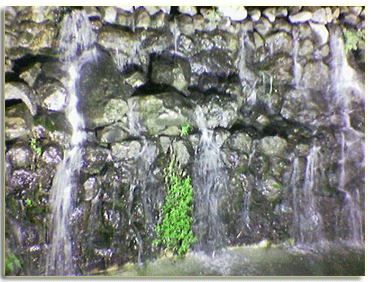
Centenary Flag Post
The Centenary Flat Post is situated near the Flower Garden adjacent to beautifull Waterfall inside Lendi Garden. Honorable President of India Shri.Ram Nath Kovind officially inaugurated Shri Sai Baba Maha Samadhi Centenary Celebrations on Sunday, 1st October 2017 at 10.55 am by hoisting the flag amidst traditional chanting of Vedic Hymns) in the newly erected flag post at Lendi Baugh.
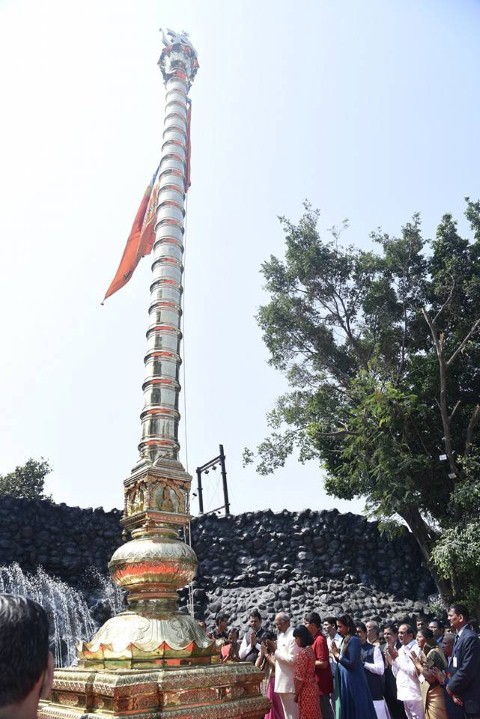
Since then, every year during Ram Navami festival Pooja is performed to the Centenary Flag Post, old flag is removed and a new flag is hoisted.
108 Foot Tall Flag Post With Grand National Flag
A new 108 foot tall flag post with a grand national flag was erected with the donation from "Flag Foundation of India" near Gate No. 01 inside Shri Saibaba Temple Complex on Thursday, 12th June 2025. The function was held with great enthusiasm in the morning. The program was inaugurated by Flag Foundation of India President and Lok Sabha MP Shri.Naveen Jindal, Shirdi Lok Sabha MP Shri.Bhausaheb Wakchoure and Shri Saibaba Sansthan Chief Executive Officer Shri.Goraksh Gadilkar (IAS).
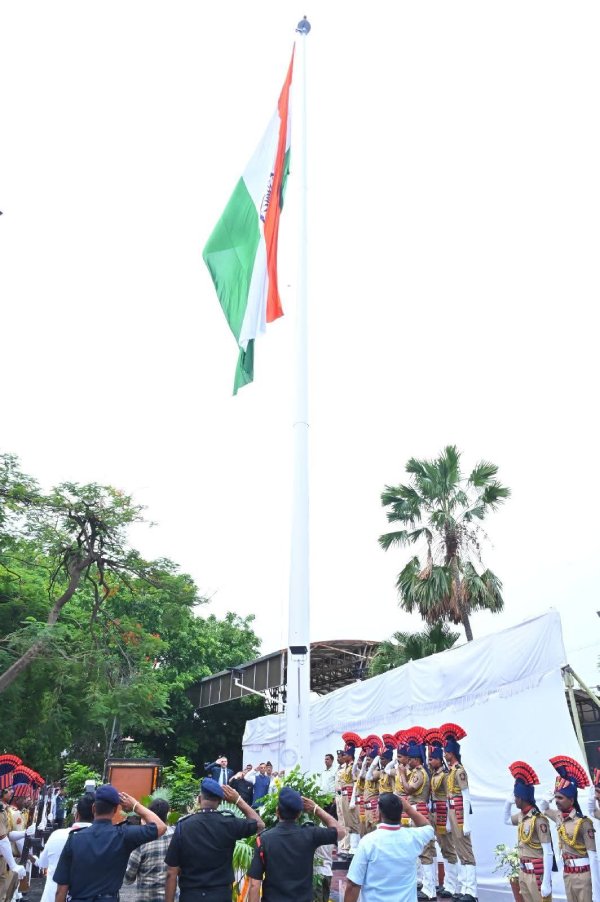
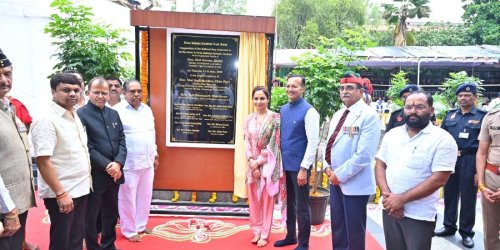
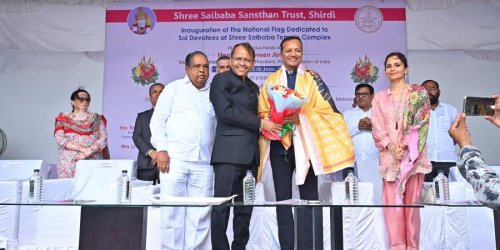
On this occasion, Deputy Chief Executive Officer Shri.Bhimraj Darade, Administrative Officers Shri.Sandeep Kumar Bhosale, Smt.Pragya Mahandule-Sinare, Shri.Vishwanath Bajaj, Chief Accounts Officer Smt.Mangala Varade, Executive Engineer Shri.Bhikan Dabhade, Security Officer Shri.Rohidas Mali, Shirdi villagers, heads of various departments of Sansthan, Sansthan employees and Sai devotees in large numbers were also present.
This magnificent national flag will surely be a source of inspiration to start a new historical era in the temple area and will continue to inspire Shri Sai devotees as a source of pride that combines both patriotism and devotion within them.
Saibaba’s Lendi Route
Baba went to Lendi Bagh twice daily in procession with musical accompaniments. After a small darbar at about 9.00 a.m. he went along with his dear and near devotees. Nana Saheb Nimonkar was usually on his right, Gopal Rao Butti at his left, Bhagoji Shinde at his back holding the embroidered umbrella, while the Chopadars in their bright uniforms accompanied him and did Lalkari. They would come out of the Dwarakamai and after walking a few steps, Baba stood leaning against his Dwarakamai for a short while. Then they proceeded to the corner in front of the Gurusthan. Here Baba stood facing the Gurusthan and made gestures with his right hand. The Bhaktas staying in Sathe Wada would eagerly await the procession and then prostrate before Baba.
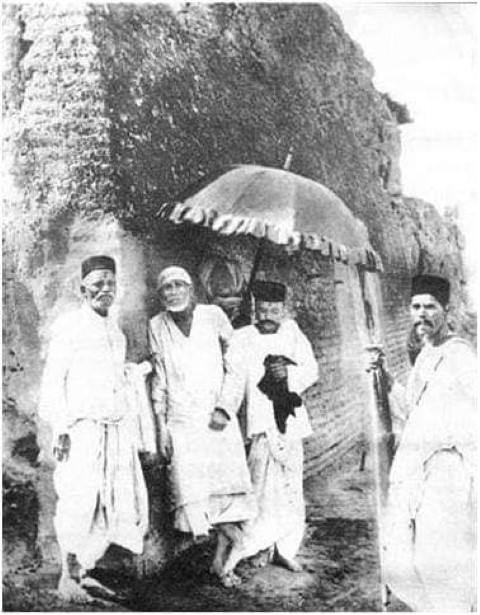
They then made a left turn and proceeded to Pilaji Gurav’s house. Here Baba rested against this house for a while. Padukas were installed at this sacred place. Then they went past the Vittal Mandir which is opposite to Seva Dham Building. From there they proceeded towards Kanif Nath’s Mandir making a right turn. This Mandir is blessed because Baba sometimes visited it. This Mandir is opposite to the Post Office.
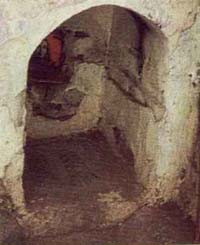
After proceeding a little further they walked adjacent to the Nagar-Manmad highway. Baba always entered Lendi Bagh Alone. While the procession of devotees waited outside. Baba returned to the Dwarakamai from Lendi Bagh by the same route.
|